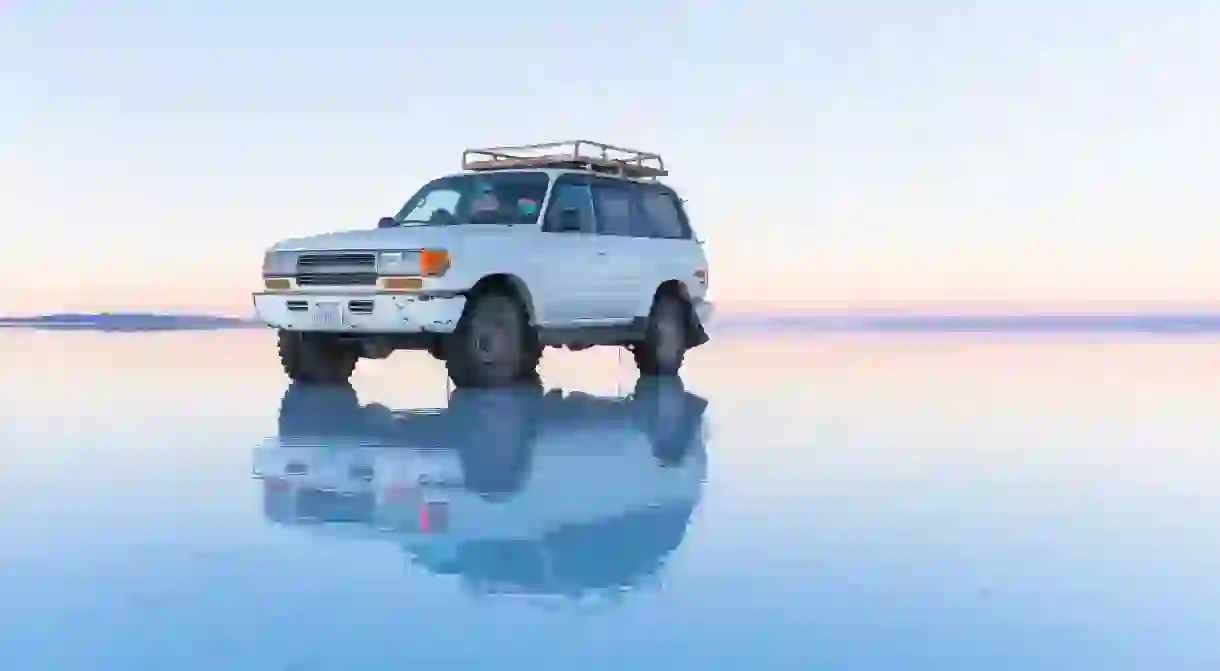The Essential Guide to Discovering Bolivia’s Salt Flats

Almost all visitors to Bolivia will go on a jeep tour of its number one attraction: the Salar de Uyuni. This incredible salt flat is famous for its dreamy landscape, which makes for an unforgettably surreal experience. Most travelers add on an extended tour of the south-west circuit to visit bubbling hot springs, colorful lagoons, steamy geysers, and snow-capped volcanoes. Read on to learn everything you need to know about visiting this incredible natural wonder.
One day or extended tours
It is possible to visit just the salt flats on a day tour starting in Uyuni at 10AM. Plenty of operators offer this option, so there’s no problem just showing up in the morning and finding a tour which should cost approximately BOB200 (around US$30). However, this is only really a good option for travelers who are seriously short on time. The longer three or four day tour is well worth the extra time and expense for the spectacular scenery involved. Just make sure you are properly acclimatized as the tour reaches staggering heights of over 17,000 feet (5,181 meters). Also be aware that these tours are not particularly luxurious. You’ll spend long days in a bumpy jeep and sleep in freezing cold dormitory accommodation with little to no running water or electricity.

Where to start the tour
There are three options of where to begin your Salar de Uyuni adventure; Uyuni, Tupiza, or San Pedro de Atacama. The best place to start a tour largely depends on what is more convenient for your itinerary.
Uyuni
This is by far the most popular option for its airport and close proximity to La Paz. However, tour operators here can be seriously shoddy with old, rundown jeeps, terrible service, and drunk drivers being the norm. The town itself is also not very inviting.
Tupiza
A pleasant little town with a wild-west sort of feel to it. Tour companies from Tupiza generally have a better reputation for safety and quality of service. Trips starting from here take four days and finish in either Uyuni or back at Tupiza.
San Pedro de Atacama
Tours can also start or finish in San Pedro de Atacama which is a great option for those going to or coming from Chile.

How to get there
Uyuni
Buses travel overnight between Uyuni and La Paz but the journey is cold and bumpy, so it’s a good idea to invest in a decent bus company such as Todo Turismo (BOB250/US$36 one way). Other companies run this route at a lower rate but they’re not as reliable.
Bolivia has a train service that runs between Oruro, Uyuni, Tupiza, and Villazon on the Argentinian border. Timetables and prices vary so check out Tickets Bolivia (English) for whatever suits you.
Amaszonas have four daily flights in each direction between La Paz and Uyuni. Tickets start from BOB536 (US$78) one-way, but can cost double or more in busy periods.

Tupiza
Taking the train to Tupiza is the best way to travel. It’s safer, more comfortable, has a dining cart (with beer), and passes through some stunning scenery.
Bus services are also available to the following places, among others: La Paz, eight hours, BOB80 (US$11); Uyuni, six hours, BOB50 (US$7); Potosi, six hours, BOB50 (US$7).
There’s no airport in Tupiza.

The best tour operators
There are plenty of unreliable operators out there so it’s worthwhile investing in a reputable company.
Uyuni
Red Planet is the only company with a solid reputation in Uyuni. They offer a variety of tours from one to three days which can include tours of the lagoons and stargazing. Prices are around US$180.
You can find three day tours for as little as US$100 by turning up in the morning and asking around, but because the quality and safety standards of these cheaper tours are often terrible, it’s better to plan in advance.
Tupiza
Tupiza Tours get consistently good reviews. Tours cost around US$180, though vary according to what’s included.
La Torre is another great option from Tupiza which offers comparable prices.

What to bring
It gets cold in Uyuni and there’s no shade anywhere, so pack plenty of warm clothes, a hat, sunglasses, and sunscreen. Food is provided on the tour but it’s a good idea to carry a few snacks and some bottled water. If you are staying in basic accommodation, make sure to bring a sleeping bag which can be hired from any tour operator. Obviously, you’re going to need a camera to capture the breathtaking views.

When to go
The Salar can be visited year round, barring some extreme weather event. The flooded mirror surface is only visible in the wet season between December and March, while the dry season between May and September has extremely cold nighttime temperatures. Make sure to rug up.

The luxury option
Travelers with some cash to splash should consider the upmarket Tayka Hotels; a series of well-managed eco-resorts including an extravagant hotel made entirely out of salt.

Now that you know everything you need to know about the salt flats, all that’s left to do is get out there and see them yourself!













